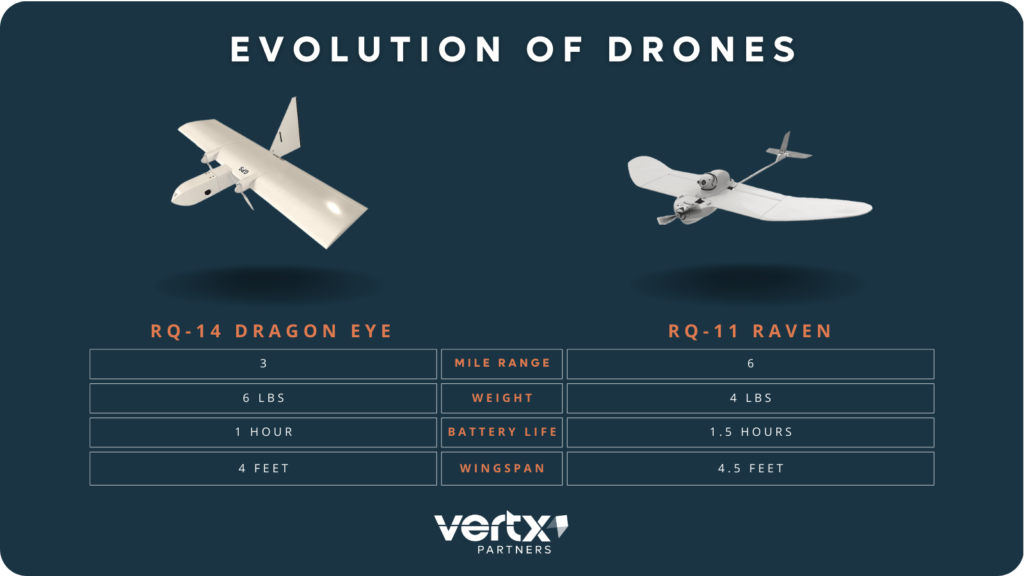What makes an innovation innovative? In “SWaP-C Explained,” Vertx tackles a common acronym that guides principles of innovation.

In our article ‘A Guide to Federal Contracting: the SBIR & STTR Explained,’ we mentioned that a critical evaluative criteria solicitation reviewers follow is the principle of SWaP-C (typically pronounced ‘swap see’).
But what exactly is SWaP-C? And what chance does your innovative product have if it doesn’t adhere precisely to its guidelines? In this guide, we’ll break down this useful acronym and the complex way each component plays into each other.
Size
The first part of SWaP-C is Size. Typically, reviewers are more interested in your innovation if you’ve managed to scale down its size relative to its competitor.
The cell phone is a classic example of this principle; gone are the days of bulky mobile phones. Motorola debuted its first commercially available cell phones in the 80s. Some of these early devices weighed a few pounds and could not be stored in customers’ pockets, for example. Contrast the shift in size to something like Apple’s iPhone Mini, an exponentially smaller and more powerful device.
Weight
The ‘W’ of SWaP-C stands for Weight. Here is a quality that often goes hand in hand with Size, though not always. An innovation can be more compact but upscale its density proportionally to make weight a moot factor.
Reduced weight is typically the goal for new products that improve old designs. We can point to the cell phone again as a device that shifted down in weight until it found a comfortable medium. It’s remained within that medium ever since.
Weight is an important factor for clients to consider because, for example, if your innovative system integrates into a moving object like a boat or plane, weight can play a factor in determining dynamics, payload, and energy expenditure.
(The ‘a’ in SWaP-C used to stand for ‘and’ back when the acronym was just SWaP. Now it is nothing more than a vestige of the older term. Leaving it in sounds better than shifting the term to ‘SWPAC.’)
Power
Nowadays, energy efficiency is the name of the game. For example, your innovative system can be more computationally powerful, but reviewers may regard it with skepticism if that Power doesn’t scale to energy efficiency.
In computer science, Moore’s Law is a good instance of systems becoming more efficient. (Moore’s Law also fulfills the aims of the previous two criteria). Gordon Moore, co-founder of Intel, proposed that the number of transistors in a circuit doubles every year or two until physical limitations prevent this from occurring. Sure enough, this trend has held for the past few decades. Moore’s Law means that our processors are getting smaller, lighter, and more powerful over time.
Cost
Here’s the least sexy term in the acronym – and the one bolted on years later by shrewd evaluators – but it is essential nonetheless. The reduction of Cost in an innovation is paramount to its success.
Cost is simple but persuasive. Say you’ve discovered a way to manufacture a product identical to its predecessor but just that much cheaper, and you may have a winner on your hands. The reasons for this are obvious and don’t need further explanation. Still, cost was added to the acronym to remind innovators of the financial constrictions by which their inventions are often reined.

The evolution of AeroVironment’s RQ-14 Dragon Eye to the RQ-11 Raven is a textbook example of SWaP-C principles in action. The Raven is an improvement over the Dragon Eye in almost every measurable respect – weight, battery power, range, etc. – and so has supplanted the latter completely.
This example also highlights that innovations between iterations need not be dramatic. Extending the battery life by a half hour and reducing the weight by a couple of pounds can be a convincing argument for outmoding heavier and less efficient predecessors filling the same niche.
Of course, the Raven has a slightly larger wingspan than the Dragon Eye, but this again illustrates the give-and-take of these applied principles.
How do these qualities interact with one another?
Say you’ve developed a smaller, lighter, and more powerful device than its predecessors, but it costs more – what chance does it have? Well, it depends on several factors, one of which may be the nitty-gritty of how much more it costs relative to the advantage it affords customers.
There is no hard and fast rule for determining when your innovation will fail if it doesn’t fulfill all of the criteria of SWaP-C, but a general rule of thumb is to be compliant in any three of the terms and allow for leeway with the fourth. If you’ve hit two, their relative advantage needs to be that much greater than the disadvantage afforded by the two areas you’ve skimped on; if you’ve hit all four, you’ve got a bona fide innovation on your hands.
Because every innovative idea is subjective and many factors are at play, reaching out to Vertx Partners to know how evaluators will grade you is crucial before starting the application process. Our team of knowledgeable industry insiders possesses decades of collective experience at your service, free of charge, today.
Become an Innovator With Us
Tell us about yourself, answer a few questions, and hit submit. It’s as easy as that to get started.
